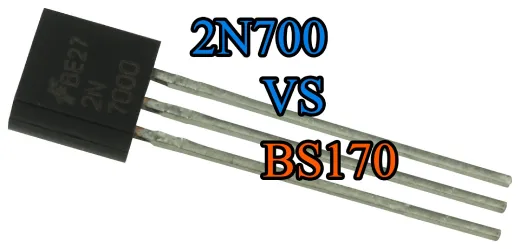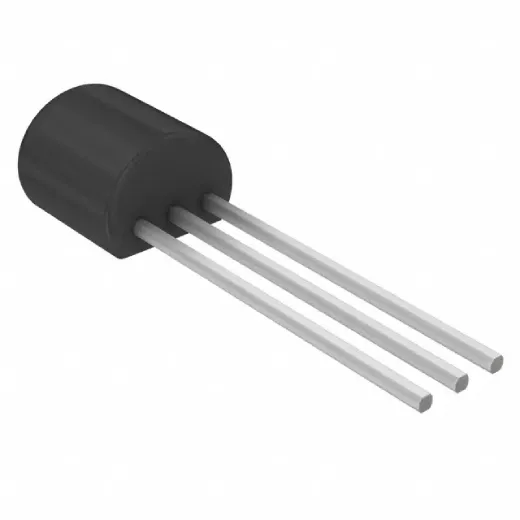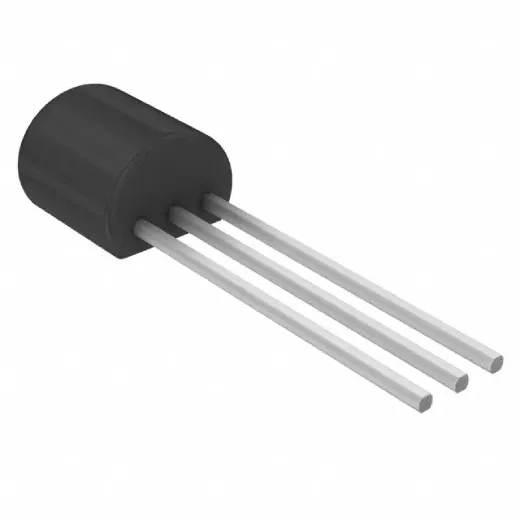2N7000 vs BS170: What's the Main Differences?
It is commonly used in a variety of electronic applications to use the 2N7000 and the BS170 N-channel MOSFETs. In spite of the similarities between the two transistors, their specifications make them suitable for different types of applications. Choosing the right component for switching, amplification, or signal modulation can be easier with a good understanding of the main differences between the 2N7000 and BS170. A detailed comparison of each transistor's electrical characteristics, performance parameters, and practical applications is conducted in order to determine which is best suited for specific needs in 2024.

What is a 2N7000?

Low on-resistance and fast switching are the distinguishing characteristics of the 2N7000. The TO-92 package is typically used for these devices, which work across a voltage range that allows them to be used in a variety of low-to-medium power applications. In digital circuits, analog switches, and power management functions, the 2N7000 provides reliable performance, simplicity, and robustness. The capability of this component to handle moderate current loads and its compatibility with CMOS and TTL logic levels make it useful in designing electronic circuits that are efficient and effective.
What is BS170?

Electronic circuits often employ the BS170 as a switching and amplification MOSFET because of its N-channel enhancement mode. With its low threshold voltage, it is easily driven by standard logic levels. It is packaged in a TO-92 package, like the 2N7000. In terms of current and voltage consumption, the BS170 is renowned for its efficiency. Due to its ease of integration and reliability, it is widely used in hobbyist projects as well as professional designs. Its versatile capabilities include signal processing, motor control, and power management, making it an excellent choice for many electronic needs.
2N7000 vs BS170: Features
2N7000
Low On-Resistance: A gate-source voltage (Vgs) of 10V results in a 2N7000 having a low on-resistance of just 1.2 ohms. Due to the low resistance, current conduction is efficient, and power loss is minimal, which is crucial in applications that require maximum efficiency.
Voltage Handling: The maximum drain-source voltage (Vds) it can accommodate is 60V. A circuit operating at higher voltages can use the 2N7000 without worrying about the risk of a breakdown due to its high voltage rating.
Current Handling: There is a maximum continuous drain current (Id) of 200mA supported by the 2N7000. In applications like digital circuits, signal processing, and small motor control, this capability makes it ideal for low to medium power consumption.
Fast Switching Speed: 2N7000 is suitable for high-speed signal switching and pulse-width modulation (PWM) applications requiring fast switching speeds.
Gate Threshold Voltage: Vgs(th) is a voltage that ranges between 2V and 3V. A TTL and CMOS logic level can be used to drive the 2N7000 directly, simplifying circuit design.
Thermal Stability and Reliability: As a result, the 2N7000 is highly reliable and thermally stable, providing consistent performance regardless of the operating conditions.
BS170
On-Resistance: When connected to a gate-source voltage of 10V, the BS170 typically has a 5 ohm on-resistance. The 2N7000 is still more efficient than the 2N7000 when it comes to low to moderate current applications, even though it's higher than the 2N7000.
Voltage Handling: There is a maximum drain-source voltage (Vds) of 60V that can be handled by the BS170. Due to this capability, circuits can be designed to withstand high voltages and provide flexible operation.
Current Handling: Up to 500 mA can be drawn continuously from the drain (Id) of the BS170. In addition to its ability to handle higher currents, it also has moderate power amplification capabilities, making it applicable to a variety of applications involving a larger load, higher current switching, and moderate power amplification.
Gate Threshold Voltage: Gate threshold voltages (Vgs(th)) range between 2V and 3V, similar to those of the 2N7000. Logic levels in this range are compatible with standard logic levels, making it easier to integrate them into digital circuits.
Fast Switching Speed: In applications requiring quick response times, the BS170 offers fast switching speeds. RF amplifiers, motor drivers, and power converters can benefit from its properties.
Thermal Performance: In spite of demanding environmental conditions, the BS170 displays robust thermal performance.
Applications
BS170 MOSFET
Switching Circuits: Switching circuits commonly use the BS170, which is ideal for controlling relays, LEDs, and other low-power components due to its ability to handle moderate current and voltage levels. This electronic switch provides reliable performance in these applications by turning on and off devices efficiently and with minimal power loss.
Motor Drivers: Small DC motors are controlled by the BS170 in motor driver circuits. This motor driver can handle continuous currents up to 500 mA, which makes it an ideal choice for robotics, toys, and small appliances. With the BS170, motor speed and direction are controlled smoothly and precisely thanks to its fast switching speed.
Amplification: Audio amplifiers and signal processing circuits can use the BS170 for low-power amplification. In audio and communication devices, it provides enough gain to amplify small signals. Because it has a low gate threshold voltage, it is easily integrated into amplification circuits due to its low gate threshold voltage.
Power Converters: A key function of the BS170 is to regulate power and switch power efficiently in DC-DC converters and voltage regulators. Power converters used in portable electronics and power supplies require fast switching capabilities, which make them compact and efficient.
RF Amplifiers and Oscillators: Radio frequency amplifiers (RF amps) use the BS170 as well as RF amplifiers and oscillators. Suitable for these applications due to its low capacitance and fast switching speeds. Wireless communication devices, transmitters, and receivers can use it to amplify RF signals and generate stable oscillations.
2N7000
Digital Logic Circuits: CMOS and TTL logic levels are directly interfaced by the 2N7000 in digital logic circuits. This device can be used to convert logic levels, gate signals, and switch between digital signals. Microcontrollers, FPGAs, and other digital logic devices are easily able to drive it due to its low gate threshold voltage, making it suitable for a wide range of digital electronics projects.
Analog Switches: The 2N7000 is able to pass analog signals with little distortion when acting as an analog switch. A sample-and-hold circuit, for example, can make use of this capability for routing audio signals, multiplexing, and sample-and-hold applications. Low on-resistance makes it ideal for precision analog applications, as it maintains signal integrity.
Power Management: Load switching, power sequencing, and battery management are all tasks that the 2N7000 can perform in power management applications. In low and medium power circuits, it is suitable for distributing power up to 60V. Power flow is managed efficiently, power consumption is reduced, and system performance is improved through the use of the 2N7000.
Motor Control: Small DC motors are usually controlled with the 2N7000. Robotics, toys, and small appliances can use this device to control motor speed and direction. It is rated for moderate current loads. Motors are operated smoothly and precisely with its fast switching speed.
Signal Processing: An electronic signal can be managed and manipulated by using the 2N7000 in a signal processing circuit. Switches, amplifiers, and video switches can be used in audio, video, and communication systems. In modern signal processing applications, its low voltage and high speed make it suitable for high speed operation.
RF Applications: Its fast switching capabilities make it suitable for low-power RF circuits, although it is not primarily designed for RF applications. A rapid signal processor can be used in circuits such as RF switches, oscillators, and amplifiers.
Low-Power Amplification: In applications such as audio circuits and signal conditioning, the 2N7000 is suitable for low-power amplification. Preamplifiers and other applications requiring small-signal amplification are suitable for its low on-resistance.
BS170 vs 2N7000 Specifications
In order to select the right MOSFET for your application, you need to understand the detailed specifications of the BS170 and 2N7000. The following table compares the key specifications of each MOSFET.
BS170 Specifications
-
Maximum Drain-Source Voltage (Vds): 60V
-
Continuous Drain Current (Id): 500mA
-
Peak Drain Current (Id): 1.2A
-
Gate-Source Voltage (Vgs): ±20V
-
Gate Threshold Voltage (Vgs(th)): 2V to 3V
-
On-Resistance (Rds(on)): 1.2Ω to 5Ω (typically 5Ω at Vgs = 10V)
-
Total Gate Charge (Qg): 8nC
-
Input Capacitance (Ciss): 60pF
-
Output Capacitance (Coss): 25pF
-
Reverse Transfer Capacitance (Crss): 5pF
-
Package Type: TO-92
-
Power Dissipation (Pd): 830mW
-
Operating Temperature Range: -55°C to 150°C
2N7000 Specifications
-
Maximum Drain-Source Voltage (Vds): 60V
-
Continuous Drain Current (Id): 200mA
-
Peak Drain Current (Id): 500mA
-
Gate-Source Voltage (Vgs): ±20V
-
Gate Threshold Voltage (Vgs(th)): 2V to 3V
-
On-Resistance (Rds(on)): 1.2Ω (typically at Vgs = 10V)
-
Total Gate Charge (Qg): 2nC to 5nC
-
Input Capacitance (Ciss): 20pF to 30pF
-
Output Capacitance (Coss): 8pF
-
Reverse Transfer Capacitance (Crss): 5pF
-
Package Type: TO-92
-
Power Dissipation (Pd): 400mW
-
Operating Temperature Range: -55°C to 150°C
Final Verdict
A lot depends on which application you are using when it comes to choosing between the 2N7000 and BS170 MOSFETs. With a continuous drain current of 500mA, the BS170 excels in situations requiring higher current handling, such as powering motors and amplifying high power loads. With robust current handling and high power dissipation, it's a good choice for applications with higher demands for reliability.
Alternatively, the 2N7000 offers a continuous drain current of 200mA, which makes it more suitable for low-current applications. In digital circuits, signal processing, and low-power switching, this device has a low on-resistance and gate charge. Interfacing with microcontrollers and other digital components is also simplified by its compatibility with standard logic levels.
Ultimately, if you need to dissipate a lot of power and have higher currents, the BS170 is a better choice. As for the 2N7000's low power requirements, high switching speed, and digital interface, it stands out as a better choice. It is important to match the MOSFET's strengths to your specific circuit requirements before choosing which one to use.
C1815 Transistor: What You Need to Know?
D882 Transistor: Understanding Its Functionality
Tip41c: What Makes It a Reliable Power Transistor?
BC338 NPN Transistor: Features, Applications, and FAQ
What is the BC547 Transistor? Its Features & Applications
2N4401 NPN Transistor: Datasheet, Applications, and Features
AC Capacitor Keeps Blowing: What to Do Next?
How to Dispose of Capacitors?
Why Do Capacitors Explode?
Regulated vs Unregulated Power Supply: What's the difference?










